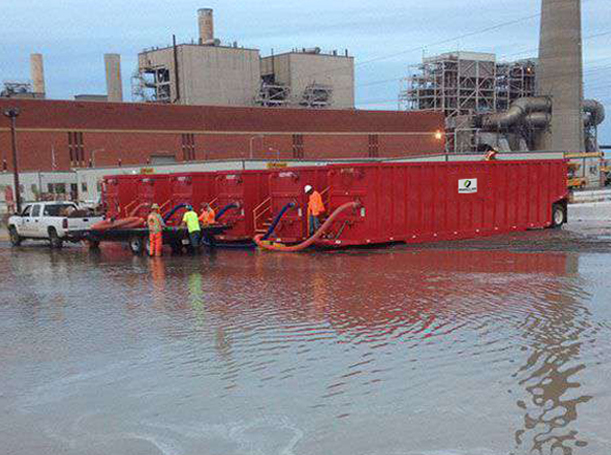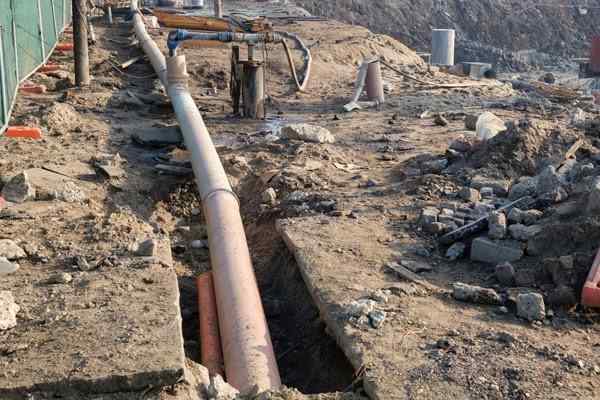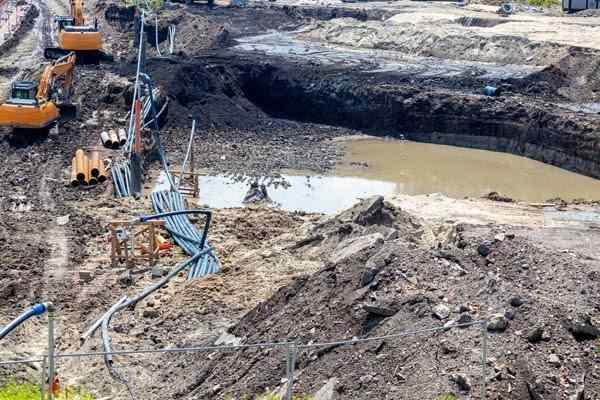The Process of Dewatering Construction Sites Explained
Dewatering is the process of removing groundwater and surface water from an excavated site. It’s crucial to perform dewatering to create dry and stable soil before construction begins.
Although natural evaporation helps remove some groundwater, dewatering pumps with large air-handling capacity assist in most water removal across construction sites. Once industries finish dewatering construction sites, they release the water into lakes, ponds, and other bodies with lower groundwater levels.
Generally, dewatering is a prerequisite in all construction projects with an excavated area, as no building can stand in a waterlogged foundation. It is essential to know the process, select the suitable dewatering method, and look at the alternatives that might help save you time and cost.
This article will introduce the importance of construction dewatering, various dewatering methods, site preparation, and dewatering discharge options.
Guide to Dewatering Construction Sites
Why is Dewatering a Construction Site Important?
Wet soil at the foundation can pose significant challenges during construction, particularly in high water table areas. Too much water can compromise the structural integrity of the building, which is why dewatering is an indispensable part of a construction project.
Removing the water can help stabilize the landscape as it prevents water from carrying the sediments away from the ground. Additionally, dewatering reduces the risk of groundwater leakages, sand soiling, upheaval failures, and basement floatation.
Groundwater dewatering is important from a construction perspective and essential for environmental protection and worker safety. Let’s look at some additional reasons why dewatering is critical.
How Improper Dewatering and Disposal Creates Environmental and Safety Hazards
A wet or muddy ground increases the risk of tripping hazards. Groundwater and surface water can damage your construction equipment. Improper dewatering can also lead to the obstruction of tasks and lower productivity.
If you’re not careful about groundwater disposal, the pumped water may end in a stream or a waterbody. Water at excavation sites may contain waste and toxins, severely affecting the local ecosystem of a sensitive area. Stagnant water pools are also a breeding ground for mosquitoes and other disease-carrying pests.
What are the Discharge Options?
To avoid mosquitoes and other pests, here are some commonly applied dewatering systems in construction to help you determine which choice suits your needs best. Information on our construction solutions page can also help assist your dewatering efforts with various dewatering equipment for rent.
- On-site dewatering: The simplest method is to retain the water, repurpose it for your construction needs, and let the rest evaporate. However, you can do on-site dewatering only if the water is free of pollutants. You must ensure that you have adequate space to store accumulated water in a safe and secure place. Generally, you also need permits for the on-site dewatering method which may require specialized equipment for groundwater remediation.
- Discharge to adjacent land: If there’s unoccupied land adjacent to your site, you can agree with the landowner to discharge water. However, you must draw a detailed agreement that thoroughly covers all legal parameters such as compensation amount, assessment of the level of pollutants, and sediment in the water.
- Discharge off-site: This method comprises collecting and transporting the water away from the excavation site for release. Sometimes the water finds applications such as irrigation. However, the reusability of water depends on its quality. Containment tanks help transport the water to the chosen site.
- Sewer system discharge: In some instances where the pollutant levels in the water are within permissible levels, you can discharge groundwater to the nearest storm inlet attached to the sewer system. First, you must review the mandates for testing and treating the water and pay the required fees. In addition, you must also test and report the water quality to obtain a permit from the local sanitary sewer agency.
- Off-site treatment: If dangerous toxins are present in the water, then the safest and potentially only construction dewatering option you may have is off-site treatment. In this case, you must take the water to a treatment facility to avoid causing damage to the environment.
You can discharge it directly from the project site for accumulated precipitation rather than construction water, as long as the water is free of pollutants other than sediments.

Important Things to Remember During the Dewatering Process
Whenever you’re pumping out groundwater or surface water, the primary consideration is avoiding the discharged water from eroding the soil on your construction site. Selecting an appropriate location to store and discharge the groundwater is equally crucial.
It’s important to keep the following things in mind before you start in on the dewatering process:
- Do not pump water directly into slopes and down-gradient areas.
- Ensure that you’ve selected the best location for discharging the collected water
- If there are any sediments in the water, remove them. Sediment bags and Sludge Dewatering Boxes are quick and effective in removing sediments.
- Avoid grease, oil, and other chemical products from being exposed to the collected water.
- Obtain local permits from the designated authority. Check with your local State Agency for construction stormwater discharge under the Clean Water Act.
What are the Steps Involved in Dewatering Construction Sites?
A typical dewatering process consists of the following steps:
Examine the water
Before you discharge water, you need to figure out the nature of the water present. Is it surface water only? Alternatively, are you also dealing with groundwater conditions? A visual examination is the first step. The next step is to determine what sediments are present and how to separate them out. You will also need to determine if the water contains any contaminants.
Visual inspection alone cannot assess the quality of the water and the level of pollutants it contains. Additional tests such as determining pH levels and the nature of contaminants are also necessary based on the results of the visual examination.
As local and federal agencies regulate discharged groundwater, you can only let the collected water off your site after tests show that there aren’t any harmful pollutants or are below a certain level.
Get permits
Nearly all construction sites require permits from federal, state, and local governments. These permit requirements for dewatering systems differ from state to state. You may also have to fulfill additional guidelines based on the type of water you’re dealing with and the location.
Secure dewatering equipment
Having dewatering equipment on hand may not always be an option. Therefore, rental equipment such as rental dewatering boxes or rental pumps are an excellent solution for dewatering a construction site without a significant capital outlay, or to move equipment in and out of the site quickly.
Treat the water
Depending on the dewatering methods you choose and the nature of the pollutants present in the water, you may have to conduct some preliminary treatment on-site before it is ready for dewatering. Typically, this includes sediment removal in dewatering bags and tanks.
Dewatering boxes, containers with filter liners, and desilting basins are also reliable treatment options.
How do you calculate the dewatering quantity?
We can calculate the dewatering quantity by estimating the total water discharge amount using the Forchheimer equation, an empirical relationship based on the depth of the excavation site and line of influence. From there, we can calculate the discharge from a single well using the yield expression.
These equations help us determine the number of wells needed to accumulate the groundwater and the number of pumps required to discharge the necessary amount.

What are the Methods of Dewatering a Construction Site?
The four most popular methods for dewatering and excavation are the WellPoint method, open sump pumping, ejector wells, and deep-well dewatering. Each offers its own pros and cons and serves a particular construction site based on its water table and soil type.
There is no one-size-fits-all solution for construction dewatering. Multiple dewatering methods exist, from using a gravity drain with drainage channels carrying the water to high-pressure water pumping, siphoning, or using large construction machinery buckets. Let’s look at the four most popular and efficient dewatering techniques:
1. Dewatering Using the Wellpoint Method
The Wellpoint method is a cost-effective yet convenient solution to dewatering challenges. It involves digging multiple wells of predetermined depths at specified distances, usually straight lines or rectangular boundaries.
A flexible swing pipe attached to a standard header pipe creates the necessary suction. The last component of the wellpoint assembly is a vacuum pump at the rear end of the header pipe. Groundwater enters these wellpoints, travels through the pipes and the pump, and finally discharges to the containment tank. However, dewatering using a wellpoint is effective only for sites about 6 meters below the pump.
2. Eductor/Ejector Wells Method
Eductor wells work on the venturi effect. The venturi principle states that when a high-pressure fluid flows through a narrow pipe section, its pressure reduces. Instead of just using a vacuum, the method also uses high-pressure water flowing through a venturi tube over the wells.
When the main water flows through a constricted section, there is a drop in its pressure. Water at the ground level is comparatively at higher pressure, so it flows towards the low-pressure supply line through riser pipes. If we install multiple pumps from a single pumping station, we can lower the water table from 10-45 meter depths.
Ejector wells are highly cost-efficient for handling low permeability soil at large depths.

3. Dewatering an Excavation Zone with Open Sump Pumping
Open sump pumping is a dewatering technique that uses gravity instead of pressure to reduce the groundwater level. The method involves creating ‘sumps’ or shallow pits along the periphery of the excavated area at a lower depth. Since the sump is lower, surrounding water converges and accumulates in the pit, where small pumps help remove the collected liquids and solids.
Open sump pumping is economical only in sandy or gravelly areas, as deep excavations in rocky grounds often involve more labor, machinery, and capital costs.

4. Deep Wellpoint Method for Construction Dewatering
The deep Wellpoint method involves drilling narrow wells (150-200 mm diameter) along the periphery of the excavation area like the conventional Wellpoint technique, just the dewatering process differs. Groundwater falls in these deep wells with the help of gravity. A submersible pump in each well helps remove groundwater and lower the water table.
Casings and retaining walls are also a part of the assembly as they prevent the well from collapsing. At the same time, geotextile dewatering bags and filters help reduce the amounts of sediments entering the pump. While the technique is expensive and time-consuming, it’s still an optimum solution at deep excavation sites requiring large discharge volumes.
What are the temporary dewatering methods?
Construction wells and tunnels can help temporarily reduce the water level at a site. However, you will have to make provisions for accumulating the water and disposing of it safely not to affect the environment.
Which is the more economical method of dewatering?
A gravity-based method such as open sump pumping is generally the most economical method of dewatering. However, it is only suited for sites with a sandy or gravelly area.
Additional Dewatering Tips
While using any of these methods, these are some tips you can follow for your construction projects:
- If possible, direct all dewatering activities to a wooded buffer before discharging water to lakes, ponds, or storm sewer inlets.
- Immediately discontinue dewatering if you observe any soil erosion at the site.
- Ensure that the water-carrying channels are stable. You need grass or vegetation to protect these channels.
- Analyze the water table for the particular ground condition.
- Avoid dewatering during heavy rains, as infiltration levels can be high.
- In the case of soils with low permeability, you can use slurry walls, sheet piles, and grout curtains to isolate the permeable strata from the water source and avoid water from entering the trench.

Benefits of Dewatering Your Construction Site
Following the best management practices offers several benefits for your construction projects. Dewatering activities keep the ground in dry and stable conditions and help avoid water from damaging construction materials and equipment.
Other advantages that construction dewatering include:
1. Stable Soil and Work Area
Uncontrolled groundwater can lead to mudslides. Your building foundation may remain unstable, while construction equipment may fail due to bogging. Dewatering prevents these hazards and ensures the worksite is safe and ready.
2. Worker Safety
Water runoff can lead to slippages, falls, and other worksite injuries. Shallow excavation areas with contaminated water may also pose long-term health risks for your employees. Removing water can help build safe conditions and reduce health hazards.
3. Scheduling
Completing your project on time is crucial as delays may have serious financial implications. Effective dewatering helps prevent unnecessary delays and keeps your project on track.
4. Protect Valuable Equipment
Excess water content at your site may affect the health of construction equipment, machinery, and even raw materials. Any damage to your machinery or building materials can lead to project delays and cost overruns. Dewatering helps keep your construction free from excess moisture.
5. Less Impact on Surrounding Environment
Stagnant water can erode the soil. Groundwater may also contain toxic waste, pathogens, and debris that can destroy local ecosystems. With a proper dewatering technique, you can effectively remove accumulated water and reduce the negative impact on the environment.
Conclusion
Dewatering is critical to construction. A failure to complete this process can lead to potential environmental violations and fines. Besides selecting the most suitable dewatering process, you must also ensure that you store and discharge groundwater safely.
Proper dewatering can help prepare the best conditions for building foundations, improve worker safety, boost productivity, and reduce negative environmental impact.
Ironclad Environmental Solutions is one of the leading providers of construction dewatering solutions. We have more than two decades of experience and a fleet of high-quality rental tanks and dewatering roll-off boxes that comply with standard guidelines. Whether you have a last-minute rental need or an emergency, we’ve got your back with our 24/7/365 services!